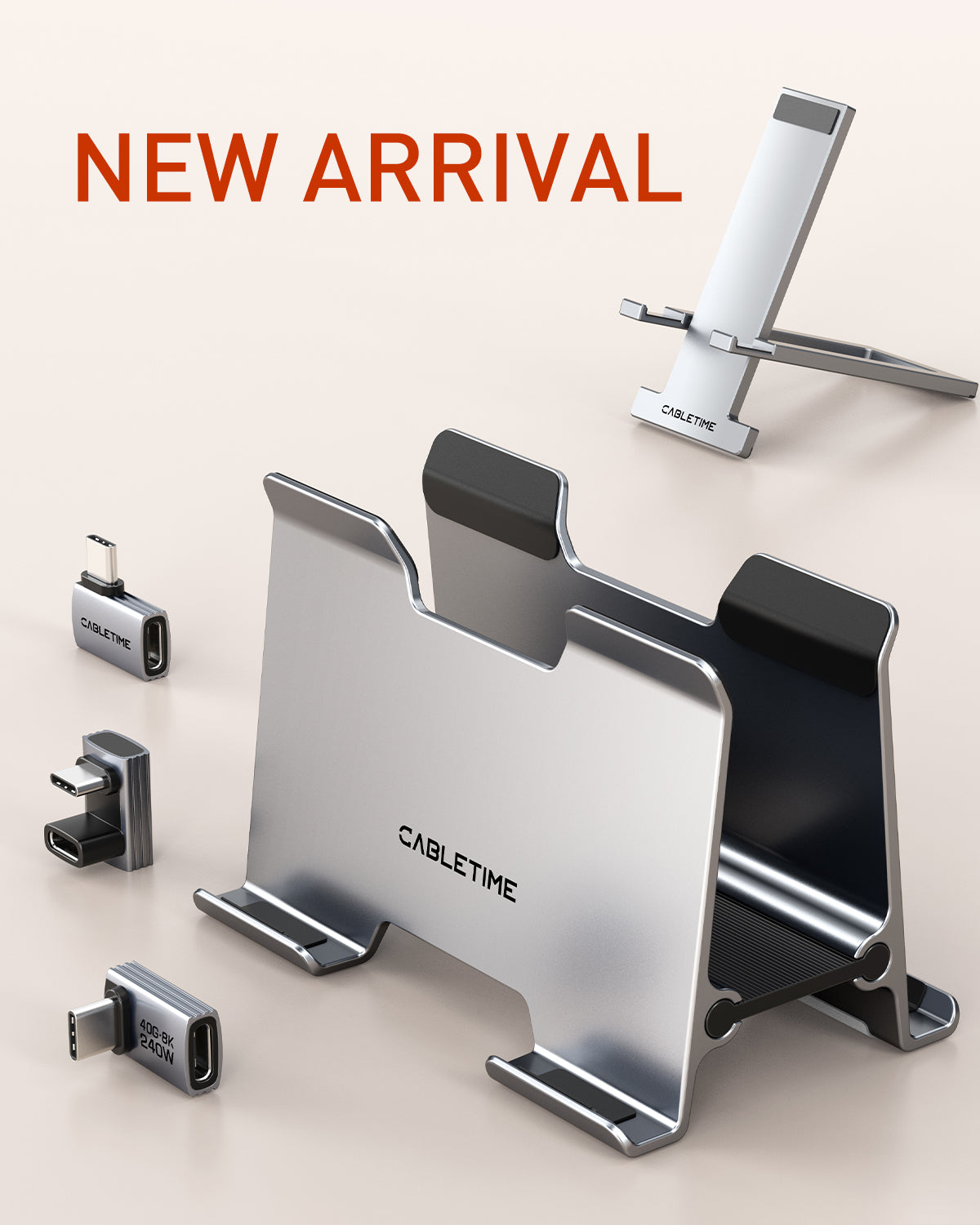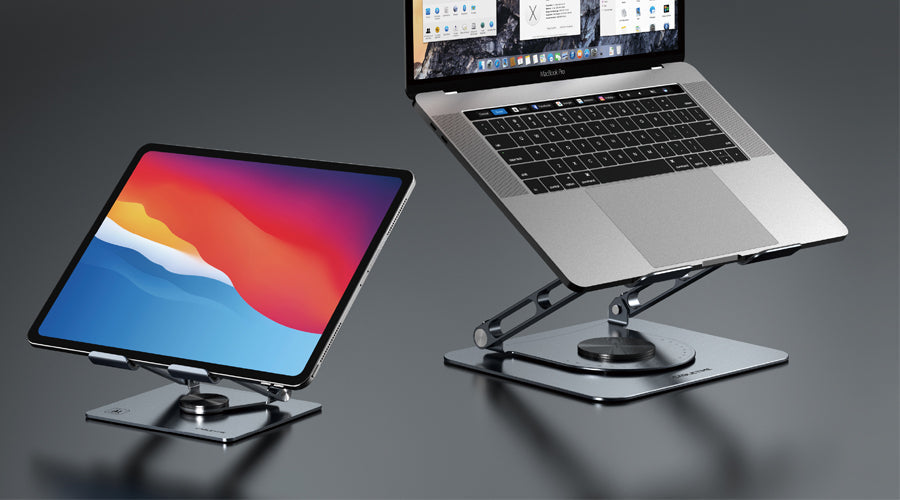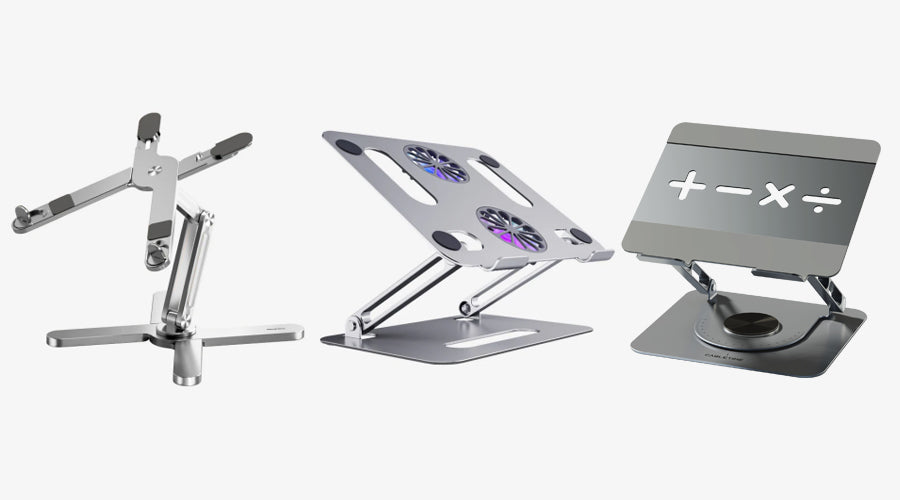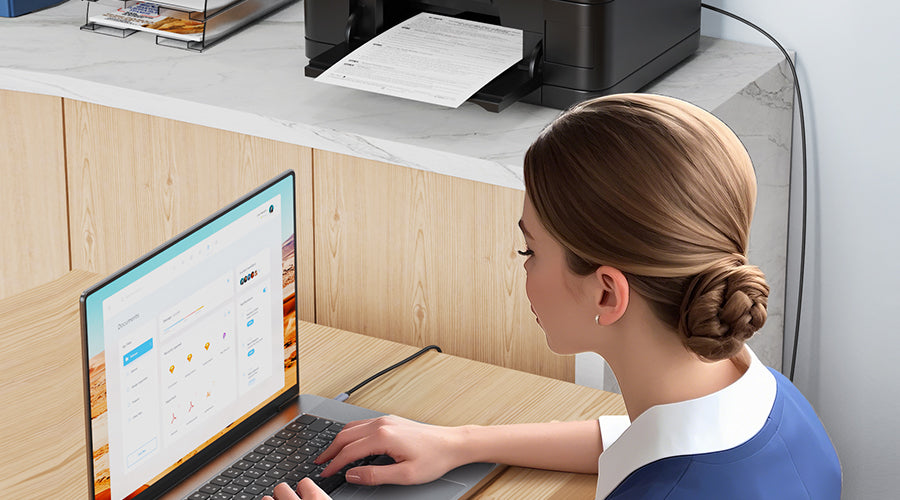หลังจากประหยัดเงินได้ก้อนโตแล้ว คุณก็ซื้อแล็ปท็อปประสิทธิภาพสูงเครื่องแรกได้ ซึ่งอาจเป็นแล็ปท็อปสำหรับเล่นเกมหรือแล็ปท็อปสำหรับมืออาชีพและนักสร้างสรรค์ ไม่ว่าจะใช้เพื่อจุดประสงค์ใดก็ตาม แล็ปท็อปประสิทธิภาพสูงจำเป็นต้องมีระบบระบายความร้อน ในบางสถานการณ์ การใช้ ขาตั้งระบายความร้อนโน้ตบุ๊ก มีความจำเป็น อุปกรณ์คอมพิวเตอร์ เช่น แล็ปท็อป ทำงานด้วยไฟฟ้า และแม้ว่าจะทำงานเต็มประสิทธิภาพ แต่อุปกรณ์เหล่านี้ก็ต้องการการระบายความร้อนเพื่อระบายความร้อนที่เกิดจากการเคลื่อนที่ของอิเล็กตรอน
แล็ปท็อปประกอบด้วยหน่วยประมวลผลกราฟิก (GPU) หน่วยประมวลผลกลาง (CPU) หน่วยความจำเข้าถึงโดยสุ่ม (RAM) โมดูลควบคุมแรงดันไฟฟ้า (VRM) และไดรฟ์จัดเก็บข้อมูลแบบโซลิดสเตต (SSD) ซึ่งจำเป็นต้องมีการระบายความร้อน หากระบบระบายความร้อนในตัวแล็ปท็อปไม่สามารถระบายความร้อนออกจากส่วนประกอบต่างๆ ได้อย่างเหมาะสม ความร้อนดังกล่าวจะทำให้ประสิทธิภาพลดลง เราจะอธิบายเรื่องนี้ในภายหลัง อย่างไรก็ตาม คุณจะต้องใช้ขาตั้งระบายความร้อนสำหรับแล็ปท็อปในบางสถานการณ์เท่านั้น เรียนรู้ได้ที่นี่! เมื่อใดที่ขาตั้งระบายความร้อนสำหรับแล็ปท็อปจึงจำเป็นต่ออุปกรณ์และสุขภาพส่วนบุคคลของคุณ
สารบัญ
ประโยชน์ของขาตั้งระบายความร้อนโน้ตบุ๊ก
ขาตั้งระบายความร้อนสำหรับแล็ปท็อปช่วยให้อุปกรณ์ของคุณและสุขภาพของคุณดีขึ้น ขาตั้งเหล่านี้ช่วยปกป้องร่างกายของคุณจากความร้อนสูงของแล็ปท็อป นอกจากนี้ยังช่วยส่งลมเย็นเข้าสู่คอมพิวเตอร์ ทำให้การไหลเวียนของอากาศดีขึ้น มาดูกันว่าขาตั้งระบายความร้อนสำหรับแล็ปท็อปมีประโยชน์อย่างไร:
ประโยชน์ของขาตั้งระบายความร้อนสำหรับแล็ปท็อป
ความร้อนที่เกิดขึ้นในแล็ปท็อปส่วนใหญ่เกิดจากความต้านทานของวัสดุตัวนำ สายไฟและชิปเซ็ตซิลิกอนอาจร้อนขึ้นเมื่อการประมวลผลเพิ่มขึ้นการสลับทรานซิสเตอร์อย่างรวดเร็วในส่วนประกอบของแล็ปท็อปอาจทำให้ส่วนประกอบเหล่านั้นอยู่ในสถานะต้านทาน ซึ่งอาจทำให้เกิดความร้อนได้ การกำจัดความร้อนเป็นสิ่งจำเป็นเพื่อให้แน่ใจว่า:
การเพิ่มประสิทธิภาพ: การโอเวอร์คล็อกและความเสถียร
การโอเวอร์คล็อกส่วนประกอบต่างๆ ถือเป็นตัวเลือกที่ดีสำหรับแล็ปท็อประดับพรีเมียมและระดับไฮเอนด์ การโอเวอร์คล็อก CPU, RAM และ GPU อาจเกี่ยวข้องกับการเพิ่มความถี่ในการทำงาน ซึ่งหมายความว่าอุปกรณ์เหล่านี้สามารถทำงานได้มากขึ้นภายในระยะเวลาที่สั้นลง ส่งผลให้ประสิทธิภาพการทำงานเร็วขึ้น แต่เนื่องจากมีกระแสไฟฟ้าไหลผ่านส่วนประกอบต่างๆ มากขึ้น จึงทำให้เกิดความร้อนมากขึ้น
หากพีซีไม่สามารถระบายความร้อนได้ ก็อาจเกิดความผิดพลาดหรือไม่เสถียรได้ ขาตั้งระบายความร้อนสำหรับแล็ปท็อปจะช่วยให้คุณดึงประสิทธิภาพสูงสุดจากแล็ปท็อปของคุณได้โดยไม่มีปัญหาเรื่องเสถียรภาพ

เทอร์มอล การลดความเร็ว: การป้องกันความร้อนของแล็ปท็อป
แล็ปท็อปสำหรับเล่นเกมหรือเวิร์กสเตชันมีการ์ดจอเฉพาะ CPU ระดับไฮเอนด์ RAM และ SSD ในกล่องขนาดเล็ก ช่องระบายไอน้ำ วัสดุที่นำความร้อน และพัดลมจะระบายความร้อนออกจากส่วนประกอบเหล่านี้ อย่างไรก็ตาม การวางแล็ปท็อปบนเตียงหรือบนตักอาจปิดกั้นเส้นทางอากาศเข้าหรือออก ส่งผลให้ความร้อนของแล็ปท็อปเพิ่มขึ้น
แล็ปท็อปสมัยใหม่จะตรวจจับความร้อนที่เพิ่มขึ้นและพยายามควบคุมโดยการลดประสิทธิภาพการทำงาน ซึ่งตรงกันข้ามกับการโอเวอร์คล็อก การทำเช่นนี้จะทำให้ส่วนประกอบต่างๆ ถูกโอเวอร์คล็อก (ลดความถี่) ซึ่งหมายความว่างานจะลดลงในหนึ่งวินาที ส่งผลให้ประสิทธิภาพลดลงและอาจเกิดการกระตุกในเกมและแอปพลิเคชัน สำหรับเกม การทำเช่นนี้จะทำให้เฟรมเรตลดลง ในขณะที่แอปพลิเคชันอาจทำให้เกิดการกระตุกหรือหยุดทำงาน

การเสื่อมเสีย อายุการใช้งาน: วงจรความร้อนและความเหนื่อยล้าจากความร้อน
พัดลมภายในของแล็ปท็อปจะถอดหัวออกจากตัวนำที่ทำจากวัสดุที่มีคุณสมบัติในการนำไฟฟ้าสูง เช่น ทองแดงหรือ SS ชิปเซ็ตซิลิกอนมีแผ่นระบายความร้อนที่เชื่อมต่อทางความร้อนโดยใช้แผ่นระบายความร้อนหรือสารเคลือบ หากคุณทำงานภายใต้อุณหภูมิสูง สารเคลือบและแผ่นระบายความร้อนเหล่านี้อาจเริ่มเสื่อมสภาพได้
การเล่นเกมหรือการตัดต่อวิดีโอและปิดแล็ปท็อปจะทำให้เกิดการเปลี่ยนแปลงอุณหภูมิอย่างรวดเร็วทันทีเนื่องจากการเปลี่ยนแปลงอุณหภูมิอย่างมีนัยสำคัญ โดยทั่วไป GPU ในขณะเล่นเกมอาจสูงถึง 80°C ด้วยการระบายความร้อนภายใน เมื่อแล็ปท็อปปิดลง อุณหภูมิจะลดลงเหลือ 25°C ซึ่งการเปลี่ยนแปลงครั้งใหญ่นี้อาจทำให้ส่วนประกอบเกิดความล้าจากความร้อนและลดอายุการใช้งานลง ในขณะที่ใช้ขาตั้งระบายความร้อนของแล็ปท็อป อุณหภูมิสูงสุดระหว่างการประมวลผลที่เข้มข้นจะลดลงอย่างมาก ตัวอย่างเช่น สูงสุด 80°C จะลดลงเหลือ 75°C ด้วยขาตั้งระบายความร้อนของแล็ปท็อป ทำให้การเปลี่ยนแปลงลดลงเหลือ 25°C เมื่อปิดเครื่อง
ประโยชน์ต่อสุขภาพของขาตั้งระบายความร้อนโน้ตบุ๊ก
ตามชื่อที่บ่งบอก แล็ปท็อปมีการออกแบบที่ต้องวางบนตัก อย่างไรก็ตาม เมื่อเวลาผ่านไป มีปัญหาต่างๆ มากมายที่เกิดจากการใช้แล็ปท็อปบนตัก ต่อไปนี้เป็นปัญหาบางประการ
ผิว การเผาไหม้
การวางโน้ตบุ๊กบนตักอาจทำให้ผิวหนังไหม้ได้ โดยอาจเกิดอาการไหม้ได้ภายใน 4 ชั่วโมง ของการใช้เป็นประจำทุกวันภายใน 3 วัน เป็นภาวะทางการแพทย์ที่มีโอกาสเกิดได้สูงซึ่งอาจทำให้เกิดเม็ดสีน้ำตาลแดง อาการดังกล่าวอาจแย่ลงเมื่อใช้แล็ปท็อปที่มีน้ำหนักมาก ศัพท์ทางการแพทย์คืออาการผิวหนังแดง และขาตั้งระบายความร้อนของแล็ปท็อปสามารถขจัดความเสี่ยงของการเกิดผิวไหม้ได้
ขาตั้งระบายความร้อนของแล็ปท็อปมาพร้อมกับพัดลมหรือแผ่นกั้นแบบพาสซีฟที่สร้างชั้นวัสดุที่ไม่นำความร้อนไปยังตัวเครื่อง ช่วยให้ผู้ใช้คอมพิวเตอร์วางแล็ปท็อปบนตักได้

ความเสียหายของอวัยวะสืบพันธุ์
การที่แล็ปท็อปได้รับความร้อนจากภายนอกเข้าสู่อวัยวะสืบพันธุ์ของมนุษย์ โดยเฉพาะในผู้ชาย อาจทำให้เกิดความเสียหายได้ การศึกษาวิจัยได้แสดงให้เห็นถึงความเชื่อมโยงระหว่างอุณหภูมิของบรรยากาศกับการผลิตอสุจิ แพทย์ไม่แนะนำให้ใช้แล็ปท็อปโดยตรงบนตัก ขาตั้งระบายความร้อนของแล็ปท็อปจะช่วยกั้นและเพิ่มการไหลเวียนของอากาศรอบๆ คอมพิวเตอร์ เพื่อลดอุณหภูมิแทนที่จะทำให้อุณหภูมิดีขึ้น
ไม่ถูกหลักสรีรศาสตร์: ปวดหลัง ปวดไหล่ ปวดคอ และอื่นๆ
การใช้แล็ปท็อปบนตักไม่คุ้มค่าอย่างยิ่ง เพราะอาจทำให้เกิดอาการปวดไหล่ ปวดหลัง ปวดคอ ปวดศีรษะ และปวดหลังค่อม อาการเหล่านี้เป็นเพียงอาการป่วยบางส่วนที่อาจเกิดขึ้นได้หลังจากใช้แล็ปท็อปบนตักเป็นเวลานาน
ขาตั้งระบายความร้อนของแล็ปท็อปที่ได้รับการออกแบบตามหลักสรีรศาสตร์ช่วยให้ผู้ใช้วางคอมพิวเตอร์บนโต๊ะและใช้งานได้ตามหลักสรีรศาสตร์มากขึ้น นอกจากจะเพิ่มประสิทธิภาพแล้ว การระบายความร้อนของแล็ปท็อปยังช่วยปรับปรุงคุณภาพชีวิตโดยรวมของมนุษย์อีกด้วย

ประเภทของขาตั้งระบายความร้อนโน้ตบุ๊ก
ปัจจุบันผู้ผลิตได้สร้างสรรค์การออกแบบขาตั้งระบายความร้อนสำหรับแล็ปท็อปมากขึ้น ขาตั้งเหล่านี้มีให้เลือกหลายรูปทรง หลายวัสดุ หลายวิธีในการระบายอากาศ พับได้ และมีช่องต่อหลายพอร์ต รายละเอียดของขาตั้งมีดังนี้:
ขึ้นอยู่กับวัสดุ
โลหะ
ขาตั้งระบายความร้อนแล็ปท็อปแบบโลหะเป็นขาตั้งที่ดีที่สุดสำหรับการทำงานที่แข็งแรง ทนทาน และใช้งานได้ยาวนาน คุณสมบัติในการนำความร้อนในตัวช่วยให้ระบายความร้อนได้ดีที่สุด ขาตั้งระบายความร้อนแล็ปท็อปแบบโลหะอาจเป็นแบบพาสซีฟหรือแอ็กทีฟก็ได้ อาจมีพัดลมฝังอยู่ภายในที่เป่าลมเข้าไปในแล็ปท็อปหรือแบบพาสซีฟที่ช่วยให้ส่วนล่างของแล็ปท็อปไม่มีสิ่งกีดขวางการผ่านของอากาศ ขาตั้งระบายความร้อนแล็ปท็อปแบบโลหะช่วยป้องกันการแตกหักจากการตกหล่น และโดยทั่วไปจะมีดีไซน์กะทัดรัดเพื่อให้พกพาสะดวก

พลาสติก
พลาสติกเป็นทางเลือกที่ราคาไม่แพงเมื่อเทียบกับขาตั้งระบายความร้อนแล็ปท็อปที่ทำจากโลหะ พลาสติกมีน้ำหนักเบาแต่โดยทั่วไปมีการออกแบบที่กว้างขวางเพื่อรองรับโครง ขาตั้งระบายความร้อนแล็ปท็อปที่ทำจากพลาสติกสามารถติดตั้งพัดลมภายในโครงได้ โดยมีโครงสร้างคล้ายตาข่ายเพื่อให้ลมผ่านได้

ซึ่งเป็นรากฐาน เกี่ยวกับวิธีการไหลเวียนของอากาศ
เครื่องดูดฝุ่นหรือเครื่องเป่าลม
การไหลของอากาศสามารถไหลเข้าหรือออกจากตัวเครื่องแล็ปท็อปได้ ขาตั้งระบายความร้อนแบบสุญญากาศช่วยให้แล็ปท็อปอยู่ห่างจากขาตั้งระบายความร้อน และทำให้ลมผ่านได้ แล็ปท็อปบางรุ่นมีตัวดูดอากาศอยู่ด้านข้าง ขาตั้งระบายความร้อนแบบสุญญากาศจะดีที่สุด เพราะขาตั้งประเภทนี้จะดูดอากาศโดยใช้พัดลมและเป่าลมออกจากด้านข้างของขาตั้งระบายความร้อน
ในกรณีของพัดลม กลไกระบายความร้อนภายในของแล็ปท็อปสามารถเพิ่มประสิทธิภาพได้ พัดลมจะเป่าลมไปที่ด้านล่างแล็ปท็อป ทำให้แล็ปท็อปอุ่นขึ้นจากด้านข้าง กลไกระบายความร้อนภายในของแล็ปท็อปจึงดีขึ้น เนื่องจากแล็ปท็อปบางรุ่นมีแรงดูดจากใต้คอมพิวเตอร์

เดี่ยวหรือ พัดลมหลายตัว
ขาตั้งระบายความร้อนแล็ปท็อปสามารถมีพัดลมตัวเดียวหรือหลายตัวก็ได้ เมื่อมีพัดลมหลายตัว พัดลมทั้งหมดจะทำงานด้วยความเร็วต่ำ จึงช่วยลดเสียงรบกวนในขณะที่ยังคงรักษาความเย็นได้อย่างเหมาะสม ในทางตรงกันข้าม ขาตั้งระบายความร้อนแล็ปท็อปที่มีพัดลมตัวเดียวจะต้องใช้พัดลมทำงานที่รอบต่อนาทีสูงเพื่อให้มีอากาศเพียงพอที่จะทำให้เกิดความเย็น
ความสามารถในการพกพา
พับได้
ขาตั้งระบายความร้อนแล็ปท็อปแบบพับได้จะช่วยให้คุณใช้งานแล็ปท็อปได้ตามหลักสรีรศาสตร์ ปลอดภัย และดีต่อสุขภาพทุกที่ที่คุณไป ระบบระบายความร้อนโน้ตบุ๊กแบบพับได้ ขาตั้งควรทำจากโลหะ ซึ่งจะช่วยให้โครงแข็งแรงพอที่จะรองรับการตกหล่นขณะพกพา ผู้ใช้สามารถพับขาตั้งระบายความร้อนเหล่านี้ให้บางกว่าแล็ปท็อปได้
เฟรมสถิตย์
มีขาตั้งระบายความร้อนแบบมีโครงคงที่ ขาตั้งระบายความร้อนแล็ปท็อปที่ทำจากพลาสติกส่วนใหญ่จะเป็นแบบคงที่ ขาตั้งประเภทนี้เหมาะอย่างยิ่งหากคุณเคลื่อนย้ายแล็ปท็อปของคุณอย่างประหยัด เนื่องจากขาตั้งประเภทนี้มักจะมีขนาดที่หนากว่า อย่างไรก็ตาม ความสามารถในการเคลื่อนย้ายของโครงคงที่อาจมีความท้าทาย
การเชื่อมต่อหลายพอร์ต
ขาตั้งระบายความร้อนสำหรับแล็ปท็อปบางรุ่นสามารถเชื่อมต่อผ่าน USB และชาร์จไฟได้ ขาตั้งระบายความร้อนสำหรับแล็ปท็อปที่มีพัดลมต้องใช้พลังงานจากภายนอก โดยปกติจะมาจากพอร์ต USB ของแล็ปท็อป ขาตั้งระบายความร้อนสำหรับแล็ปท็อปขั้นสูงอาจมาพร้อมกับ USB-A และ ยูเอสบี-ซี พอร์ตสำหรับการเชื่อมต่อพอร์ตหลายพอร์ตหรือตัวเลือกการชาร์จที่ได้รับการปรับปรุง
วิธีค้นหาขาตั้งระบายความร้อนสำหรับแล็ปท็อปของคุณ
การหาขาตั้งระบายความร้อนแล็ปท็อปที่เหมาะสมนั้นต้องตรวจสอบคอมพิวเตอร์ของคุณอย่างละเอียด ผู้ซื้อที่สนใจขาตั้งระบายความร้อนแล็ปท็อปสามารถปฏิบัติตามแนวทางของเราเพื่อเลือกอุปกรณ์ที่เหมาะสมที่สุดได้
- สังเกต:สังเกตแล็ปท็อปของคุณจากด้านบน ด้านล่าง และด้านข้าง มองหาช่องระบายอากาศและตาข่ายที่ให้อากาศผ่านได้ ตรวจสอบขนาดของคอมพิวเตอร์เพื่อให้แน่ใจว่าพอดีกับขาตั้งระบายความร้อนของแล็ปท็อป
- ขาตั้งระบายความร้อนโน้ตบุ๊กแบบดูด:หากแล็ปท็อปของคุณมีช่องระบายอากาศทั้งสองด้าน ก็อาจมีช่องรับและช่องระบายอากาศทั้งสองด้าน ในกรณีนั้น ให้ใช้ขาตั้งระบายความร้อนแล็ปท็อปที่มีกลไกดูดเพื่อระบายความร้อนได้ดีขึ้น
- พัดลมระบายความร้อนโน้ตบุ๊ก:หากคุณพบตาข่ายใต้แล็ปท็อปเพื่อให้ลมผ่านและระบายอากาศด้านใดด้านหนึ่ง คุณจะต้องมีขาตั้งระบายความร้อนที่จะเป่าลมไปที่ด้านล่างแล็ปท็อป
- ตรวจสอบอุณหภูมิ:ใช้ซอฟต์แวร์เช่น HWiNFO เพื่อตรวจสอบอุณหภูมิของส่วนประกอบภายในแล็ปท็อป
- ขีดจำกัดอุณหภูมิ:ตรวจสอบว่าอุณหภูมิ CPU, GPU, RAM หรือ SSD ของคุณเกินขีดจำกัดด้านล่างหรือไม่:
| ส่วนประกอบ | ช่วงอุณหภูมิสูงสุดโดยทั่วไป (°C) |
| ซีพียู AMD | 90 - 105 |
| ซีพียู Intel | 90 - 100 |
| จีพียู AMD | 95 - 110 |
| GPU ของ Nvidia | 80 - 90 |
| แรมระบบ | 85 - 95 |
| แรมการ์ดจอ | 90 - 100 |
| ฮาร์ดดิสก์ไดรฟ์ (HDD) | 50 - 70 |
| โซลิดสเตทไดรฟ์ (SSD) | 85 - 95 |
- พัดลมรอบสูง:หากอุณหภูมิของคุณเกินช่วงสูงสุด คุณจะต้องใช้ขาตั้งระบายความร้อน RPM ที่สูงขึ้น
- ขาตั้งแบบพาสซีฟ:นักเดินทางบ่อยครั้งควรเลือกขาตั้งแล็ปท็อปแบบกะทัดรัดที่ใส่ในกระเป๋าเป้หรือเคสแล็ปท็อปได้พอดี ขาตั้งแบบพาสซีฟที่ทำจากโลหะเหมาะสำหรับจุดประสงค์ดังกล่าว
- ขาตั้งระบายความร้อนโน้ตบุ๊กตามหลักสรีรศาสตร์:ผู้ใช้ที่มีอาการปวดหลัง ปวดคอ หรือมีปัญหาสุขภาพอื่นๆ ที่เกี่ยวข้องกับการใช้งานแล็ปท็อปเป็นเวลานาน ควรเลือกขาตั้งระบายความร้อนแล็ปท็อปตามหลักสรีรศาสตร์ ขาตั้งเหล่านี้ช่วยให้ร่างกายยังคงอยู่ในตำแหน่งธรรมชาติระหว่างทำงานหรือเล่น
- การเล่นเกมและการสร้างเนื้อหา:เกมเมอร์และผู้สร้างคอนเทนต์ควรเลือกใช้ขาตั้งระบายความร้อนแล็ปท็อปที่มีพัดลมหลายตัวเพื่อเพิ่มประสิทธิภาพการระบายความร้อน เพื่อหลีกเลี่ยงการลดความร้อนหรือฮาร์ดแวร์ทำงานไม่เต็มประสิทธิภาพ
- การเชื่อมต่อหลายพอร์ต:สุดท้าย ขาตั้งระบายความร้อนแล็ปท็อปที่มีพอร์ต USB เหมาะอย่างยิ่งหากคุณต้องการพอร์ตหลายพอร์ตเพื่อเชื่อมต่ออุปกรณ์เสริมภายนอก
5 คำถามที่เกี่ยวข้อง
- ขาตั้งระบายความร้อนทำงานเพื่อระบายความร้อนให้กับแล็ปท็อปได้อย่างไร
ขาตั้งระบายความร้อนของแล็ปท็อปสามารถเป่าลมไปที่คอมพิวเตอร์หรือถอดออกเพื่อเพิ่มความเย็นได้ ขาตั้งเหล่านี้ช่วยให้อากาศหมุนเวียนได้ดีขึ้นบริเวณช่องระบายอากาศของกลไกระบายความร้อนภายในแล็ปท็อป ขาตั้งระบายความร้อนเหล่านี้ยังสามารถทำงานแบบพาสซีฟได้ด้วย โดยมีตัวเครื่องเป็นโลหะและโครงพับได้
- ฉันควรพิจารณาปัจจัยอะไรบ้างในการเลือกขาตั้งเครื่องทำความเย็น?
พิจารณาพัดลมหลายตัวสำหรับแล็ปท็อปสำหรับเล่นเกมและสร้างคอนเทนต์ นอกจากนี้ ให้พิจารณาถึงความสะดวกในการพกพา ขนาด กลไกการระบายความร้อน การเชื่อมต่อพอร์ตหลายพอร์ต วัสดุ หลักสรีรศาสตร์ ความกว้าง 8 นิ้ว และรอบต่อนาทีของพัดลม
- การใช้ขาตั้งระบายความร้อนสามารถเพิ่มประสิทธิภาพการทำงานของแล็ปท็อปได้หรือไม่?
หากแล็ปท็อปของคุณมีอุณหภูมิลดลงหรือร้อนจนทนไม่ได้ ขาตั้งระบายความร้อนสามารถช่วยลดอุณหภูมิของแล็ปท็อปได้ การลดอุณหภูมิลงจะช่วยลดอุณหภูมิของ SSD และช่วยให้ CPU, GPU และ RAM ทำงานได้เร็วขึ้น
- การใช้ขาตั้งระบายความร้อนมีข้อเสียอะไรบ้าง?
ขาตั้งระบายความร้อนสำหรับแล็ปท็อปที่มีพัดลมหลายตัวที่รอบสูงอาจเพิ่มระดับเสียงและลดปริมาณการสำรองแบตเตอรี่ ขาตั้งระบายความร้อนบางรุ่นอาจมีขนาดใหญ่และพกพาลำบาก ขาตั้งระบายความร้อนคุณภาพสูงที่มีพัดลมสองตัวขึ้นไป ขาตั้งเหล่านี้มีโครงโลหะซึ่งเหมาะสำหรับเสียงรบกวนต่ำ พกพาสะดวก และดีไซน์แข็งแรง
- ฉันควรใช้ขาตั้งระบายความร้อนกับแล็ปท็อปบ่อยเพียงใด?
ขาตั้งระบายความร้อนสามารถช่วยให้แล็ปท็อปมีอายุการใช้งานที่ยาวนานขึ้นและใช้งานได้ยาวนานขึ้น นอกจากนี้ยังช่วยป้องกันปัญหาสุขภาพ เช่น คุณภาพของอสุจิต่ำ ผิวหนังไหม้ มะเร็งผิวหนัง หลังค่อม และอาการปวดเมื่อยตามร่างกาย การใช้ขาตั้งระบายความร้อนร่วมกับแล็ปท็อปจะช่วยปรับปรุงสุขภาพส่วนบุคคลและอุปกรณ์ของคุณ






ทิ้งข้อความไว้
เว็บไซต์นี้ได้รับการคุ้มครองโดย hCaptcha และมีการนำนโยบายความเป็นส่วนตัวของ hCaptcha และข้อกำหนดในการใช้บริการมาใช้